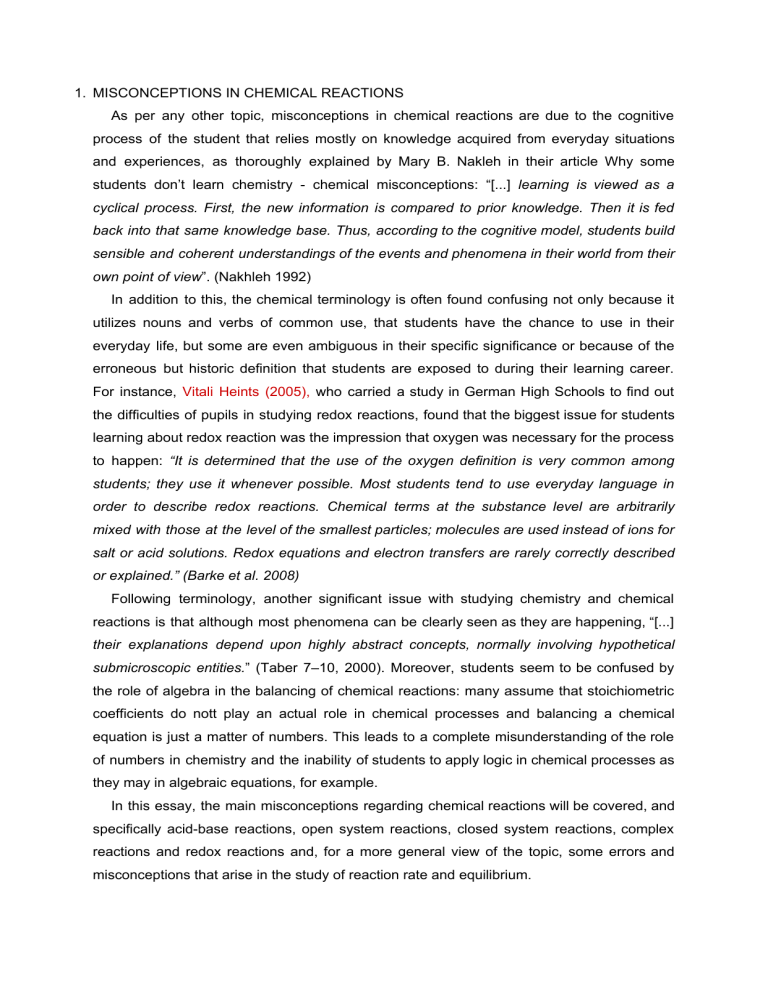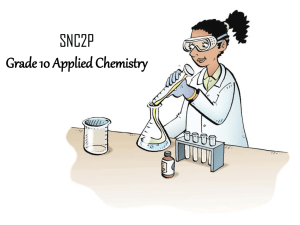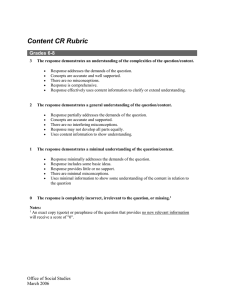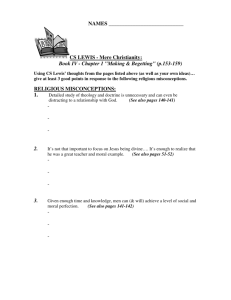MISCONCEPTIONS IN CHEMICAL REACTIONS
advertisement

1. MISCONCEPTIONS IN CHEMICAL REACTIONS As per any other topic, misconceptions in chemical reactions are due to the cognitive process of the student that relies mostly on knowledge acquired from everyday situations and experiences, as thoroughly explained by Mary B. Nakleh in their article Why some students don’t learn chemistry - chemical misconceptions: “[...] learning is viewed as a cyclical process. First, the new information is compared to prior knowledge. Then it is fed back into that same knowledge base. Thus, according to the cognitive model, students build sensible and coherent understandings of the events and phenomena in their world from their own point of view”. (Nakhleh 1992) In addition to this, the chemical terminology is often found confusing not only because it utilizes nouns and verbs of common use, that students have the chance to use in their everyday life, but some are even ambiguous in their specific significance or because of the erroneous but historic definition that students are exposed to during their learning career. For instance, Vitali Heints (2005), who carried a study in German High Schools to find out the difficulties of pupils in studying redox reactions, found that the biggest issue for students learning about redox reaction was the impression that oxygen was necessary for the process to happen: “It is determined that the use of the oxygen definition is very common among students; they use it whenever possible. Most students tend to use everyday language in order to describe redox reactions. Chemical terms at the substance level are arbitrarily mixed with those at the level of the smallest particles; molecules are used instead of ions for salt or acid solutions. Redox equations and electron transfers are rarely correctly described or explained.” (Barke et al. 2008) Following terminology, another significant issue with studying chemistry and chemical reactions is that although most phenomena can be clearly seen as they are happening, “[...] their explanations depend upon highly abstract concepts, normally involving hypothetical submicroscopic entities.” (Taber 7–10, 2000). Moreover, students seem to be confused by the role of algebra in the balancing of chemical reactions: many assume that stoichiometric coefficients do nott play an actual role in chemical processes and balancing a chemical equation is just a matter of numbers. This leads to a complete misunderstanding of the role of numbers in chemistry and the inability of students to apply logic in chemical processes as they may in algebraic equations, for example. In this essay, the main misconceptions regarding chemical reactions will be covered, and specifically acid-base reactions, open system reactions, closed system reactions, complex reactions and redox reactions and, for a more general view of the topic, some errors and misconceptions that arise in the study of reaction rate and equilibrium. 2.1 ACID-BASE REACTIONS The major issue students have in regards to neutralization reactions is highlighted when speaking of weak acids and bases reacting and the solution not ending up with a neutral pH value. Students associate a neutralization reaction with a neutral pH, following the word association. When Schmidt (1994) asked students about the neutralization as it is seen when asking them about the of acetic acid and sodium hydroxide solution and found that most students came up with a pH of 7. He also recorded some comments made by students in this regard: “The product is slightly basic, so why call it neutralization?” and “It is not good to call this a neutralization, we had two solutions and made a relatively neutral one out of them, but in the end we have a pH value that is not neutral.”(Schmidt & International Council of Associations for Science Education 1994) 2.2 OPEN SYSTEM REACTIONS Open system reactions often involve the oxidation or combustion of some material. The main difficulty students encounter when studying open system reactions is the role of the atmosphere, or oxygen itself, and its property. Students in fact struggle with the mass of gasses, and they either think a gas does not possess a mass or weight at all or they weight less than normal materials. In the case of the rust on a nail, for instance, some students could associate the change in the appearance of the nail to a reaction, although they did not connect oxygen having to do with it. Even when asked about the change in mass, most students disregarded any involvement of oxygen as “it doesn’t have any mass” (Driver et al, A. 1985 E. . Schollum, 1981) In another study, performed by Meheut (1985), when faced with the instance of a burning candle, students do not appear to think that wax is being consumed by the flame but more ambiguously that the flame is just causing the wax to evaporate and melt, assigning a combustion reaction the characteristics of a change of state. The role of oxygen is not well understood either, although it surely is included in the process: “Although most 11 - 12 year olds knew oxygen was needed for burning, they could not explain exactly how the oxygen was used. ”. Most kids thought it was “eaten up” and consumed by the flame, and was not associated to the wax melting. 2.3 CLOSED SYSTEM REACTIONS Closed system reactions are a very common place to start introducing the topic of reactions to chemistry students however they are not the simplest ones; the concepts of gas and mass, as seen in open system reactions, still plays a great role in creating misconceptions for the pupils. Since many seem to associate a gas with a non-material substance that doesn’t weight or possess mass, when facing a closed system evaporation, for example, some end up believing that the mass present inside the system has been reduced anyway. Similar misconceptions are found in dissolving reactions for example of sugar in water, or of effervescent tablets in water, an explanation of which (given by a student) was that "When they made the tablet they put little air bubbles in", and the thought that the bubbling and the relative gas formed could be caused from rearrangement of atoms seem indiscernible. (Kind, 2005) 2.4. COMPLEX REACTIONS Complex reactions are generally not taught at high school level, either for lack of time or perceived complexity of the topic. This means that most students do not encounter complex reactions until the subject is picked up in university lectures. From a study conducted in the form of a questionnaire presented to 60 college students by Martina Zwartscholten (2007) and Christoph Lisowski, the results hinted that this subject is very poorly understood by students, few simple formulas are memorized but no deep understanding of processes or equations is displayed. The questionnaire included the main topics of complex chemistry and although some formulas were recognized by the students, the representations they were asked to draw in some of the questions was not always coherent with the answer given, disclosing the very hazy ideas that students have with regards to complex chemistry. In general, students may know how to explain the proceeding of a reaction in chemical term but do not have a complete understanding of what exactly goes on during the process, as highlighted by Problem 6 of the questionnaire, which only 15% of students correctly completed: Problem 6: The first step of aluminum production is the separation of aluminum hydroxide (Al(OH)3) from the bauxite using concentrated sodium hydroxide solution (NaOH). a) Show the chemical equation for dissolving solid aluminium hydroxide: Al(OH)3(s) + OH-(aq) ⟶ [Al(OH)4]-(aq) b) Write down chemical symbols of the involved particles: Figure 3.1 Examples of mental models concerning the aluminum hydroxide reaction 2.5 REDOX REACTION Regarding Redox reactions, besides the misconceptions mentioned in the introduction to this chapter, another very common misconception regards electrodes and galvanic cells: when presented with a model of a cell, most students automatically assume that the left electrode is the positive electrode, simply because of convention. This translate in the students assigning the name of the electrode based on its position. This misconception has roots in chemical textbooks, Michael J. Sanger and Thomas J. Greenbowe (1999) found in their analysis of ten different chemistry textbooks and interviewed college students: “The relative placement of the anode and cathode half-cells as depicted in the illustrations in each textbook was analyzed [...] Two textbooks had an equal number of illustrations in which the anode was drawn as the left and as the right halfcell, four textbooks favored one position over the other, and four textbooks exclusively drew the anode as the left half-cell. A second convention that may suggest that the anode is always the electrode on the left is the cell notation [...] Only three of these textbooks explicitly state that the arrangement of half-cells in the cell notation is done by IUPAC convention. ”(Sanger & Greenbowe 1999) 3. HOW TO AVOID THESE MISCONCEPTIONS All of these misconceptions arise either from previous misconceptions that undermine the learning of even the most basic chemical processes or from a lack of understanding of the more complex topics. One way to reduce the uprising of misconceptions is obviously making the students experience as many chemical phenomena as possible not as an explanation but in order to make pupils question what is happening. For example, a good way to visualize the “mass” of a gas in a closed system evaporation would be to make use of a balloon, which would inflate as the reaction proceed and act as a visual aid for the students, or a conductive test for neutralization reactions. In complex reactions, however, students might need more than an experiment to understand the mechanism and the logistic of the reaction, and for that implementing the use of “mental models” might improve students’ learning. The use of molecular models might help visualize reaction complexes and intermediates as well. Finally, historical theories, as fundamental and important as they can be, inevitably create an absurd amount of misconceptions that would be easily solved if they weren’t mentioned at all in the beginning of a topic, but only at a later date in a form of “History of chemistry”. This would help students understand the concepts without being fed the unnecessary definitions that don’t apply or are completely wrong. References Barke, H.-D., Hazari, A. & Yitbarek, S., 2008. Misconceptions in Chemistry: Addressing Perceptions in Chemical Education, Springer Science & Business Media. Driver, R., Guesne, E. and Tiberghien, A., 1985. Children’S Ideas In Science McGraw-Hill Education (UK), ed., Heints, V.: Redoxreaktionen: Empirische Erhebung zu Schuelervorstellungen und Vorschlaege zu deren Korrektur. Staatsexamensarbeit. Muenster 2005 Meheut, M., 1985. Pupils’ (11–12 year olds) conceptions of combustion. The European Journal of Science Education,, 7(1), pp.83–93. Nakhleh, M.B., 1992. Why some students don’t learn chemistry: Chemical misconceptions. Journal of chemical education, 69(3), p.191. Sanger, M.J. & Greenbowe, T.J., 1999. An Analysis of College Chemistry Textbooks As Sources of Misconceptions and Errors in Electrochemistry. Journal of chemical education, 76(6), p.853. Schmidt, H.-J. & International Council of Associations for Science Education, 1994. Problem Solving and Misconceptions in Chemistry and Physics: Proceedings of the 1994 International Symposium, Schollum, B., 1981. Chemical change: A working paper of the Learning in Science Project, Distributed by ERIC Clearinghouse. Taber, K.S., 7–10, 2000. Challenging Misconceptions in the Classroom? In British Educational Research Association Annual Conference. Cardiff University. Zwartscholten, M.: Komplexchemie: Fehlvorstellungen bei Studierenden der Chemie. Staatsexamenarbeit. Muenster 2007




